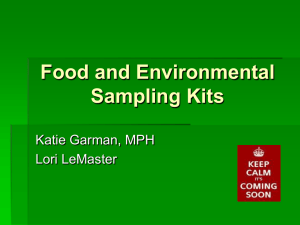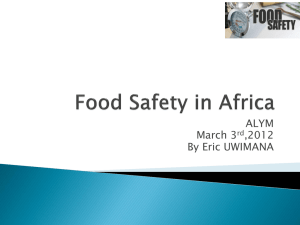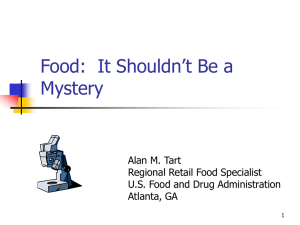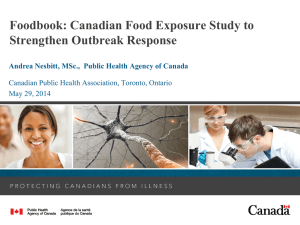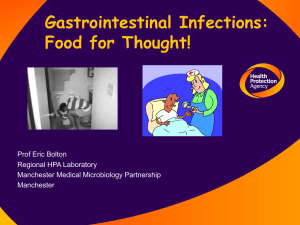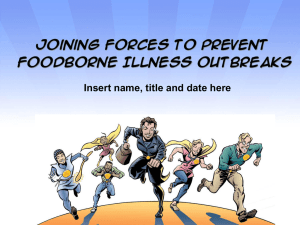Foodborne disease and the home
advertisement
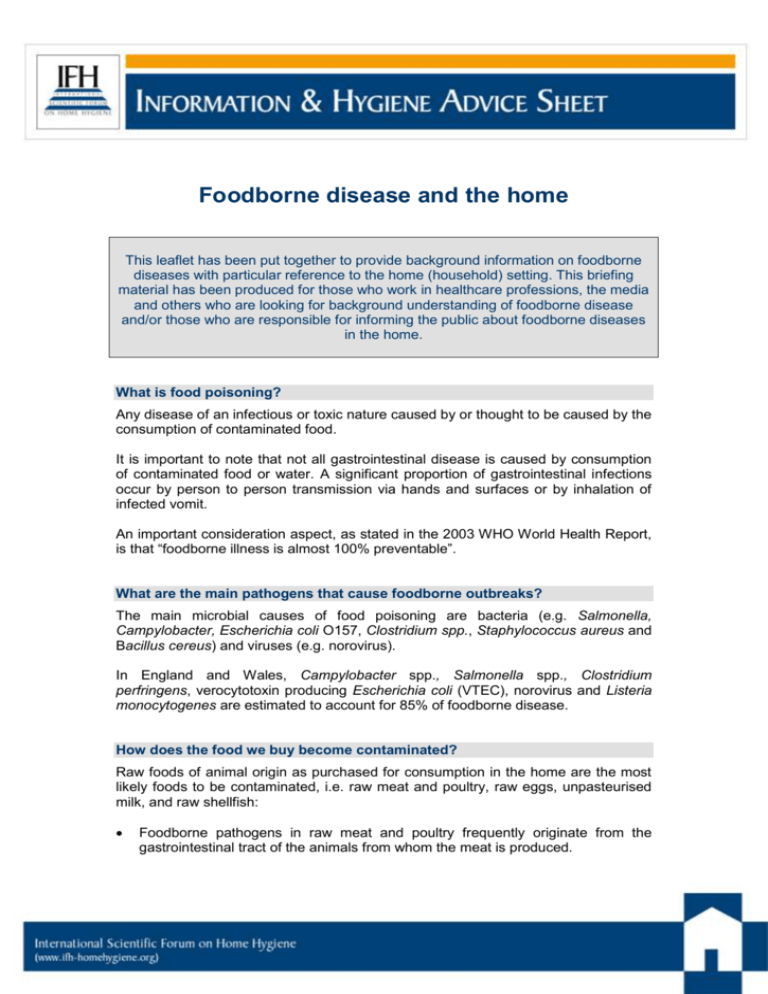
Foodborne disease and the home This leaflet has been put together to provide background information on foodborne diseases with particular reference to the home (household) setting. This briefing material has been produced for those who work in healthcare professions, the media and others who are looking for background understanding of foodborne disease and/or those who are responsible for informing the public about foodborne diseases in the home. What is food poisoning? Any disease of an infectious or toxic nature caused by or thought to be caused by the consumption of contaminated food. It is important to note that not all gastrointestinal disease is caused by consumption of contaminated food or water. A significant proportion of gastrointestinal infections occur by person to person transmission via hands and surfaces or by inhalation of infected vomit. An important consideration aspect, as stated in the 2003 WHO World Health Report, is that “foodborne illness is almost 100% preventable”. What are the main pathogens that cause foodborne outbreaks? The main microbial causes of food poisoning are bacteria (e.g. Salmonella, Campylobacter, Escherichia coli O157, Clostridium spp., Staphylococcus aureus and Bacillus cereus) and viruses (e.g. norovirus). In England and Wales, Campylobacter spp., Salmonella spp., Clostridium perfringens, verocytotoxin producing Escherichia coli (VTEC), norovirus and Listeria monocytogenes are estimated to account for 85% of foodborne disease. How does the food we buy become contaminated? Raw foods of animal origin as purchased for consumption in the home are the most likely foods to be contaminated, i.e. raw meat and poultry, raw eggs, unpasteurised milk, and raw shellfish: Foodborne pathogens in raw meat and poultry frequently originate from the gastrointestinal tract of the animals from whom the meat is produced. The surfaces of the meat become contaminated during handling and preparation for retail sale. In some cases the animal is perfectly healthy e.g. cows who carry E. coli 0157 are themselves “healthy”. There are many opportunities for meat or poultry to become contaminated when it is slaughtered and prepared for sale. Animals can also transmit foodborne pathogens to humans via their produce e.g. milk, eggs Filter feeding shellfish (e.g. oysters, mussels and clams) may be contaminated if they are harvested from sewage-contaminated waters Vegetables or other farm produce can be contaminated if they are grown or washed in polluted water. Food can become contaminated by an infected food handler who is involved in preparation of food for retail sale Food can become contaminated in shops/supermarkets by cross contamination from other contaminated foods. Cross contamination can occur via hands, surfaces and cloths where hygiene standards are poor An infected family member or a person who is a carrier e.g. of Salmonella, may act as the primary source of infection in the home. People who are infected can continue to shed the organism in their faeces for a time after recovery Through domestic pets and domestic animals. Domestic cats and dogs can act as reservoirs of Salmonella and Campylobacter. In the United States, it is reported that 10-27% of dogs may carry Salmonella and up to 39% of dogs may carry Campylobacter. Some facts and figures In a 2003 report the WHO concluded that about 30% of reported foodborne outbreaks in the WHO European region over the past decade were caused by food consumed in private homes. 1 Studies confirm that Salmonella and Campylobacter are present in retail poultry in many/most countries across the world, although the rates of infection (the percentage of samples which are contaminated) vary significantly from one country to another: the 2011 European Community Summary Report on foodborne infections states that overall, 5.9 % of samples of chicken meat within the EU were positive for Salmonella, although rates from individual countries were mostly between 0 and 42%.3 The European Community Summary Report on foodborne infections states that Campylobacter were most commonly detected in fresh poultry meat where on average 31.3% samples were positive, although rates varied considerably between differing countries, ranging from 3.2-75.8.3 The importance of broiler meat as a source of human Campylobacter infections was also illustrated by the reported food-borne outbreak data from 2011. Approximately half (17 out of 37) of the Campylobacter outbreaks, in which information on the implicated food vehicle was provided, were linked to broiler meat. a UK study showed that Salmonella and Campylobacter can sometimes be isolated from the outside of retail poultry packaging. Page 2/11 in the United States, more than half of raw chicken is estimated to be contaminated with Camplylobacter. a survey of retail poultry in Bangkok and Nairobi revealed Campylobacter contamination rates of 40 and 77%. The 2012 European Community Summary Report on foodborne infections reported that Bovine meat is believed to be a major source of food-borne VTEC infections for humans. In 2011, 8 member states reported testing of 4347 bovine meat units of which 1.4% were found to be VTEC-positive and 0.3 % VTEC O157-positive.3 Data on the incidence of other food poisoning organisms can be found in the 2010 European Community Summary Report on foodborne infections3 How to prevent food poisoning in the home? The four key principles of food hygiene are: keep clean - prevent cross contamination, separate raw and cooked foods, cook foods thoroughly, store foods correctly: Keep clean – prevent cross contamination Good food hygiene means preventing cross contamination. This means stopping germs from spreading from people, pets, pests and contaminated food or water, into food which is being prepared for eating Preventing cross contamination means making cooking utensils, hands, hand and food contact surfaces, and cleaning cloths and sponges hygienically clean at the times that matter – before and after use Wash hands after handling food which may be contaminated and disinfect using an alcohol handrub or sanitiser Hygienically clean all food contact surfaces, utensils and cloths after handling and preparation of raw foods using a disinfectant cleaner**. Hygienically clean all contact surfaces, utensils and cloths before handling and/or preparing ready to eat foods. Cloths and sponges become contaminated when they are used to wipe up spills from food, and bacteria can multiply with time once on damp cloths and sponges. Afterwards the cloths and sponges serve as a vector for further spread of pathogens to the hands of the user, to the surfaces wiped and then to many articles throughout the kitchen. Separate Raw and Cooked Foods Food poisoning organisms can move from contaminated foods to other foods by direct contact. Ensure that raw foods are kept separate from cooked foods Cook food thoroughly Good food hygiene means cooking food thoroughly to kill pathogenic organisms. Food can be made safe by heating it to a certain temperature for a sufficient amount of time Store food properly Foods must be stored at the right temperature e.g. hot foods kept hot, chilled foods kept cold. Store food in a refrigerator or freezer. Page 3/11 Neither freezing nor refrigeration will inactivate bacteria, which means that on transferring these foods to room temperature they may become heavily contaminated again if left at warm temperatures. Also: Wash any foods such as fruit and vegetables to be eaten raw thoroughly under clean running water. The “WHO 5 keys to food hygiene“ gives guidance on food hygiene in developing countries includes a fifth principle: Use safe water and raw materials It is not possible to say which of these factors is the most common cause of food poisoning. Some UK data on foodborne IID outbreaks in the home in the UK suggested that: 39% of outbreaks are due to inappropriate storage of food. 31% of outbreaks are due to inadequate cooking. 20% of outbreaks are due to cross-contamination or contamination from an infected food handler. The purpose of cooking food is to reduce the numbers of pathogenic bacteria or viruses to a level insufficient to cause disease. Both home-cooked foods and purchased cold foods such as cold meats should contain only small numbers of human pathogens that are insufficient to cause disease. However, if left in warm or ambient temperatures and moist conditions, overnight organisms can multiply and the food can become highly contaminated by the next day. After heating, food must spend the minimum amount of time between 30ºC–45ºC. If not eaten immediately, food must be cooled immediately to prevent the potential growth of bacteria. Freezing prevents bacteria from growing and refrigeration will delay it. Neither freezing nor refrigeration will inactivate bacteria, which means that on transferring these foods to room temperature they may become heavily contaminated again if left at warm temperatures. In the kitchen, micro-organisms can be transferred from one food to another food by using the same chopping board or knife to prepare both without washing the surface or knife in between. A food that is fully cooked can become re-contaminated if it touches other contaminated raw foods or drips and spills from raw foods. Cloths and sponges become contaminated when they are used to wipe up spills from food, and bacteria can multiply with time if they are present on damp cloths and sponges. Afterwards the cloths and sponges serve as a vector for further spread of pathogens to the hands of the user, to the surfaces wiped and then to many articles throughout the kitchen. For example: A UK study has shown that during the preparation of a meal in a domestic kitchen using a contaminated chicken almost 1 in 5 (17%) of hands and hand and food contact surfaces become contaminated with Salmonella or Campylobacter In a US study of 23 patients infected with E. coli O157, 80% of the cases were thought to have originated from consumption of hamburgers in the home. Food preparers in those homes were significantly less likely to report Page 4/11 washing their hands or work surfaces. The transmission was believed to have occurred more often when the hands of food preparers were allowed to crosscontaminate other food and utensils An outbreak of norovirus at a wedding reception affecting 50% of guests was due to cross-contamination of potatoes from a contaminated sink, into which the food handler had previously vomited. Further information on the occurrence, survival and transmission of foodborne pathogens in the home can be found in a 2013 IFH report2 Good Food hygiene practice in the home is described in more detail in: 1. Home hygiene - prevention of infection at home: a training resource for carers and their trainers. (2003) International Scientific Forum on Home Hygiene. Available from: http://www.ifh-homehygiene.com/best-practice-training/homehygiene-%E2%80%93-prevention-infection-home-training-resource-carers-andtheir 2. Home Hygiene in Developing Countries: Prevention of Infection in the Home and Peridomestic Setting. A training resource for teachers and community health professionals in developing countries. International Scientific Forum on Home Hygiene. Available from: www.ifh-homehygiene.org/best-practice-training/homehygiene-developing-countries-prevention-infection-home-and-peri-domestic. (Also available in Russian, Urdu and Bengali) *How to wash hands: Handwashing “technique” is very important. Rubbing with soap and water lifts the germs off the hands, but rinsing under running water is also vital, because it is this process which actually removes the germs from the hands. The accepted procedure for handwashing is: Ensure a supply of liquid soap, warm running water, clean hand towel/disposable paper towels and a foot-operated pedal bin. Always wash hands under warm running water. Apply soap. Rub hands together for 15–30 seconds, paying particular attention to fingertips, thumbs and between the fingers. Rinse well and dry thoroughly. In situations where soap and running water is not available an alcohol- based hand rub or hand sanitiser should be used to achieve hand hygiene: Apply product to the palm of one hand. Rub hands together. Rub the product over all surfaces of hands and fingers until your hands are dry. Note: the volume needed to reduce the number of germs on hands varies by product. In high risk situations where there is an outbreak in the home, handwashing followed use of an alcohol rub/sanitiser should be encouraged One very simple thing which people can do which can significantly reduce the risk of disease is to avoid putting their fingers to their mouth. Page 5/11 **Disinfectants and disinfectant cleaners: Use a disinfectant or disinfectant/cleaner such as a bleach-based product, which is active against all types of organisms (bacteria and viruses). For more details on choosing the appropriate disinfectant, consult the IFH information sheet “Cleaning and disinfection: Chemical Disinfectants Explained”. Also consult the manufacturers’ instructions for information on the “spectrum of action”, and method of use (dilution, contact time etc). For bleach (hypochlorite) products, use a solution of bleach, diluted to 0.5% w/v or 5000ppm available chlorine. Household bleach (both thick and thin bleach) for domestic use typically contains 4.5 to 5.0% w/v (45,000-50,000 ppm) available chlorine. In situations where “concentrated bleach” is recommended a solution containing not less than 4.5% w/v available chlorine should be used. Bleach/cleaner formulations (e.g sprays) are formulated to be used “neat” (i.e. without dilution). It is always advisable however to check the label as concentrations and directions for use can vary from one formulation to another. How common is food poisoning? The 1990s saw rapid increases in the incidence of food poisoning in the developed world, and finally a call to action to reverse this trend. Although rates of foodborne diseases have levelled off, they remain unacceptably high. As stated in the 2003 WHO World Health Report, is that “foodborne illness is almost 100% preventable”. Most data on GI disease comes from outbreaks reported to national surveillance and is based on investigation of cases or outbreaks which are reported through national surveillance schemes. The annual Community Summary Report by the European Food Safety Authority (EFSA) and European Centre for Disease Prevention and Control (ECDC) gives an overview of the latest trends and figures on the occurrence of zoonoses and zoonotic agents in humans, animals and foodstuffs in the 27 European Union (EU) Member States and the European Free Trade Association (EFTA) countries.3 Further information on the incidence and prevalence of food borne infection can be found European Centre for Disease Prevention and Control Annual Epidemiological Report.4 These publications are updated annually. Data for the US is generated through the National Outbreak Reporting System.5 Surveillance systems also operate in Australia6, New Zealand7 and Canada8 Most cases of gastrointestinal infection are not reported to national surveillance systems, making it difficult to determine the true burden in the population. This means that the data obtained by these systems represents a significant underestimate of the true number of cases. Also, most of the data reported to national surveillance systems relates to outbreaks of infection rather than isolated (sporadic) cases. This means that estimating the number of foodborne infections arising in the home is also difficult, because many of these are sporadic and a large proportion are not reported. It is important to note that not all gastrointestinal disease is caused by consumption of contaminated food or water. A significant proportion of these infections occur by person to person transmission via hands and surfaces or by inhalation of infected vomit. The proportion of cases which are foodborne or water borne as opposed to those due to person to person or other modes of transmission is difficult to estimate and relatively little data is available. The 2003 WHO report9 stated that, of the total gastrointestinal infection outbreaks (including foodborne disease) reported in Europe Page 6/11 during 1999 and 2000, 60 and 69%, respectively, were due to person-to-person transmission. An analysis of UK outbreaks in 200010 suggested that 19% of Salmonella outbreaks and more than half of E. coli O157 outbreaks are transmitted by non-foodborne routes. According to the UK Food Standards Agency, up to half of the annual cases of IID are food poisoning.11 The following is a summary of data from Europe, US, Australia and New Zealand. In the EU, for 201l there was a total of 5,648 reported food-borne outbreaks resulting in 69,553 human cases, 7,125 hospitalisations and 93 deaths. Most reported outbreaks were caused by Salmonella, bacterial toxins, Campylobacter and viruses; however, the outbreak with most cases was caused by Shiga toxin-producing Escherichia coli/verotoxigenic Escherichia coli and associated with sprouted seeds. In 2011, the notification rate and confirmed number of cases of human campylobacteriosis in the EU increased compared with 2010. Human campylobacteriosis continued to be the most commonly reported zoonosis with 220,209 confirmed cases. The number of confirmed cases of campylobacteriosis in the EU has followed a significant increasing trend in the last four years, along with a clear seasonal trend. The proportion of Campylobacter-positive food and animal samples remained at levels similar to previous years, with the occurrence of Campylobacter continuing to be high in broiler meat. The number of salmonellosis cases in humans decreased by 5.4% compared with 2010 and by as much as 37.9% compared with 2007. In total, 95,548 confirmed salmonellosis cases were reported in 2011. It is assumed that the reduction in salmonellosis is mainly a result of the successful Salmonella control programmes in poultry. The number of listeriosis cases decreased slightly compared with 2010, and 1,476 confirmed human cases were reported in 2011. As in previous years, a high fatality rate (12.7 %) was reported among the cases. A total of 9,485 confirmed verotoxigenic Escherichia coli infections were reported in 2011, which was a 2.6-fold increase compared with 2010. Most were caused by serogroup O157. As many as 1,064 cases were, however, reported of serogroup O104 (20.1 % of cases) due to a large outbreak primarily in Germany. The number of reported cases of verotoxigenic E. coli human cases has been increasing in the EU since 2008. In animals and food most verotoxigenic E. coli-positive findings were made in cattle and bovine meat, but the bacteria were also detected in some other animals and foodstuffs. In the UK, an estimate of the true GI infection rates comes from a community- based study of the incidence of GI. This indicates that the true number of sporadic community cases of IID is up to 17 million. Of these, norovirus accounts for 3 million cases and 130,000 GP consultations, and Campylobacter is responsible for 500,000 cases and 80,000 GP consultations.12 The data suggest that up to 1 in 4 people in the UK suffer from a GI illness every year. This community-based study, estimated that only one in 147 cases of gastrointestinal illness is detected by surveillance and that, for every one reported case of Campylobacter, Salmonella, rotavirus and norovirus, another 9.3, 4.7, 43 and 288 cases, respectively, occur in the community. As stated above, according to the UK Food Standards Agency, around half of the annual cases of IID are food poisoning.11 In the US, CDC state that the true estimate of the foodborne disease burden is that each year roughly 1 in 6 Americans (or 48 million people) get sick, 128,000 are hospitalized, and 3,000 die of foodborne diseases. They state that “The 2011 Page 7/11 estimates provide the most accurate picture yet of which foodborne bacteria, viruses, and microbes ("pathogens") cause the most illnesses in the United States” 13 In the USA, a total of 17,883 laboratory-confirmed cases of infection were reported in the 10 FoodNet surveillance areas. The number of cases and incidence per 100,000 population were reported as follows: Salmonella (6,790; 14.92), Campylobacter (5,818; 12.79), Shigella (2,848; 6.26), Cryptosporidium (1,216; 2.67), E. coli O157 (545; 1.20), E. coli non-O157 (260; 0.57), Yersinia (163; 0.36), Listeria (122; 0.27), Vibrio (108; 0.24), and Cyclospora (13; 0.03). In 2007, outbreak-associated infections accounted for 86 (15.8%) of E. coli O157 cases and 364 (5.4%) of Salmonella cases. This is similar to proportions in previous years. In their 2007 report, CDC assessed overall that, although significant declines in the incidence of certain foodborne pathogens have occurred since 1996, these declines all occurred before 2004. Comparing 2007 with 2004–2006, the estimated incidence of infections caused by Campylobacter, Listeria, Salmonella, Shigella, STEC O157, Vibrio, and Yersinia did not decline significantly, and the incidence of Cryptosporidium infections increased. According to Hall et al the primary reported mode of transmission in most acute gastroenteritis outbreaks was person to person (52%), followed by foodborne (35%), waterborne (2%),animal contact (1%), and environmental contamination (0.2%). Person-to-person transmission was implicated in most outbreaks caused by norovirus (66%) and Shigella spp. (79%), whereas foodborne transmission was implicated in most outbreaks caused by Salmonella spp. (72%) and STEC (63%). Among the 3,052 reported outbreaks for which a single exposure setting was reported, health care facilities were the most frequent settings settings (49%), followed by restaurants etc (22%), schools or day-care facilities (10%), and private residences (7%). Private residences and restaurants were the most frequent exposure settings for outbreaks caused by Salmonella spp. (32% and 36%, respectively) and STEC (46% and 20%,respectively). In Australia, it is estimated that 5.4 million cases of foodborne disease occur annually, costing an estimated $1.2 billion per year. In 2010, OzFoodNet sites reported 30,035 notifications of 9 diseases or conditions that are commonly transmitted by food.6 The most frequently notified infections were Campylobacter (16,968 notifications) and Salmonella (11,992 notifications). The most frequently notified Salmonella serotype was Salmonella Typhimurium, accounting for 44% of all Salmonella notifications. OzFoodNet sites also reported 1,640 outbreaks of gastrointestinal illness affecting 30,193 people and resulting in 722 people being hospitalised. There were 89 deaths associated with these outbreaks. The majority of outbreaks (81%, 1,330/1,640) were due to person-to-person spread, 9% (154/1,640) were suspected or confirmed to have been transmitted by contaminated food, 9% (155/1,640) had an unknown mode of transmission and 1 outbreak was due to transmission from animal to person. Foodborne and suspected foodborne outbreaks affected 2,146 persons and included 157 hospitalisations. Fifteen deaths were reported during these outbreaks. A single food source was identified for 43 outbreaks, 21 of which were associated with the consumption of dishes containing raw or minimally cooked eggs; the majority (n=20) due to S. Typhimurium. In New Zealand, during 2011, there were 581 reported outbreaks of gastrointestinal disease, involving 7796 cases. A total of 204 cases required hospitalisation and four cases died. Campylobacter spp accounted for 29 (5%) of outbreaks.7 The most commonly identified enteric pathogen was norovirus in 31.2% of outbreaks, followed by Giardia spp. in 12.4%, Campylobacter spp. and Page 8/11 Cryptosporidium spp. both 5.0% of outbreaks. The most common settings for exposure or transmission were the private home environment (24.8%). Person-toperson transmission was reported for 78.0% of outbreaks in 2011. Foodborne and environmental transmission were reported for 21.0% and 17.7% of outbreaks, respectively. Multiple modes of transmission were implicated in 33.0% of outbreaks. Contamination of food was the most common factor contributing to foodborne outbreaks (40.2%), followed by time/temperature abuse (38.5%,). For New Zealand it is reported that, over the last 10 years substantial changes have occurred in the reporting of modes of outbreak transmission. Over this period, person-to-person transmission emerged as the most frequently reported mode, a change from foodborne transmission which was often the most reported mode between 2001 and 2006. The proportion of foodborne outbreaks reported in 2011 (21.0%, 122/581) is similar to what was reported from 2007 to 2010, but less than from 2001 to 2006 (range 28.3% to 52.9%). Between 2001 and 2011, the number of outbreaks with person-to-person transmission reported increased more than threefold (from 132 to 453, respectively). In 2011 the number of outbreaks with person-toperson transmission was more than three times higher than any other mode of transmission. Environmental transmission is emerging as a more frequently reported mode of outbreak transmission rising from 6.2% of outbreaks in 2001 to 20.3% in 2010 and 17.7% in 2011, respectively. In developing areas, it is often difficult to establish whether a disease outbreak is waterborne or foodborne or involves direct faecal/oral transfer. Most disease that is spread by water is also spread through faecal contamination or person-to-person contact or in contaminated food. Relatively few countries in the developing world have surveillance programmes which publish data on foodborne disease, which means that comprehensive data on the burden of foodborne disease is not available. This is particularly true in Africa and the Middle East where very few countries have surveillance programmes. By contrast all Central/South American and Caribbean countries have some form of notification system. The situation is improving and it is hoped that by 2020 a surveillance network will cover most countries. It is likely that the proportion of infections which are foodborne (relative to other modes of spread e.g. faecal oral transmission not involving food) is lower in developing countries compared with developed countries because of the frequent and more varied opportunities for other modes of transmission, and because the zoonotic agents (particularly Salmonella and Campylobacter) which are especially associated with foodborne infections in developed countries are less important relative to other enteric pathogens. The overall rates of foodborne infection, however, are likely to be higher in developing compared with developed countries. Because keeping food hot or cold is usually not practical, pathogens may be able to grow in home-prepared foods and those sold in food service operations and street vendors. A major concern in developing countries is babies and young children. Although breast feeding is recommended and has been shown to reduce enteric infections, women in low income families may not produce enough milk, making supplemental weaning foods necessary. It is estimated that Enterotoxigenic E. coli, Enteropathogenic E. coli, Shigella, Vibrio cholera and parasites are the main problems in developing countries, but it is uncertain how many cases are attributed to food. Salmonella is still the most important agent, with S. enteritidis and S. typhimurium being of most concern. Page 9/11 Campylobacter is one of the most frequently isolated bacteria from stools of people infected with diarrhoea in developing countries. Major sources of Campylobacter are food and environmental contamination: Campylobacteriosis is considered to be a particular burden in the developing world, partly because Campylobacter-associated diarrhoea and bacteraemia occur in HIV/AIDS patients. Other “facts about” sheets giving information on food poisoning 1. 2. 3. 4. 5. 6. 7. National resource on Infection Control. www.nric.org.uk. UK Public health England – foodborne outbreaks http://www.hpa.org.uk/web/HPAweb&Page&HPAwebAutoListName/Page/1274 087663703. US Centre for Disease Control and Prevention. http://www.cdc.gov/foodsafety/facts.html Centre for Diseases Control and Prevention. Preliminary FoodNet data on the incidence of infection with pathogens transmitted commonly through food – in 10 states, 2006-2013. http://www.cdc.gov/mmwr/preview/mmwrhtml/mm6315a3.htm European Centre for Disease Control and Prevention. Food and waterborne diseases and zoonoses. http://ecdc.europa.eu/en/healthtopics/food_and_waterborne_disease/Pages/ind ex.aspx NHS Choices. Food poisoning and how to avoid it. http://www.nhs.uk/conditions/Food-poisoning/Pages/Introduction.aspx. WHO, Five keys to safer food. 2006. Food Safety Department. World health Organisation. www.who.int/foodsafety/publications/consumer/manual_keys.pdf This fact sheet was last updated in 2014 Further Information 1 2 3 4 Rocourt, J, Moy G, Vierk, R, Schlundt, J. The present state of foodborne disease in OECD countries. Food Safety Department, World Health Organization, Geneva, Switzerland. 2003. Available at: http://www.who.int/foodsafety/publications/foodborne_disease/en/OECD%20Fin al%20for%20WEB.pdf. Accessed 10/11/2011 Bloomfield SF. Exner M, Signorelli C, Nath KJ, Scott EA. 2012. The chain of infection transmission in the home and everyday life settings, and the role of hygiene in reducing the risk of infection. http://www.ifh-homehygiene.com/best-practice-review/chain-infectiontransmission-home-and-everyday-life-settings-and-role-hygiene The European Union Summary Report on Trends and Sources of Zoonoses, Zoonotic Agents and Food-borne Outbreaks in 2011. Report of EFSA and ECDC Downloadable from http://ecdc.europa.eu/en/publications/Publications/zoonosesfood-outbreaks-report-2011-ecdc-efsa.pdf EFSA Journal 2013;11(4):3129 European Centre for Disease Prevention and Control. Annual Epidemiological Report 2013. Page 10/11 5 6 7 8 9 10 11 12 13 http://www.ecdc.europa.eu/en/publications/Publications/annual-epidemiologicalreport-2013.pdf Hall AJ, Wikswo ME, Manikonda K, Roberts VA, Yoder JS, Gould LH. Acute gastroenteritis surveillance through the National Outbreak Reporting System, United States. Emerg Infect Dis. 2013. http://dx.doi.org/10.3201/eid1908.130482 . Monitoring the incidence and causes of diseases potentially transmitted by food in Australia: annual report of the ozfoodnet network, 2010. http://www.ozfoodnet.gov.au/internet/ozfoodnet/publishing.nsf/Content/reports-1 Summary of Outbreaks in New Zealand 2011. Institute of Environmental Science and Research Limited. July 2012. https://surv.esr.cri.nz/PDF_surveillance/AnnualRpt/AnnualOutbreak/2011/2011O utbreakRpt.pdf Estimates of Food-borne Illness in Canada. http://www.phac-aspc.gc.ca/efwd- emoha/efbi-emoa-eng.php World Health Organisation. Several foodborne diseases are increasing in Europe. Press Release EURO/16/03. Available from http://www.euro.who.int/eprise/main/who/mediacentre/PR/2003/20031212_2x. Le Baigue S, Long S, Adak GK, O’Brien SJ. Infectious intestinal disease – it’s not all foodborne! PHLS 25th Annual scientific conference, 2000. Food Standards Agency. A report of the study of infectious intestinal disease in England (TSO, 2000). The Longitudinal study of infectious intestinal disease in the UK (IID2 study): incidence in the community and presenting to general practice Tam CC, Rodrigues LC, Viviani L, et al. Gut (2011). doi:10.1136/gut.2011.238386. Estimating Foodborne Illness: An Overview http://www.cdc.gov/foodborneburden/index.html Page 11/11
